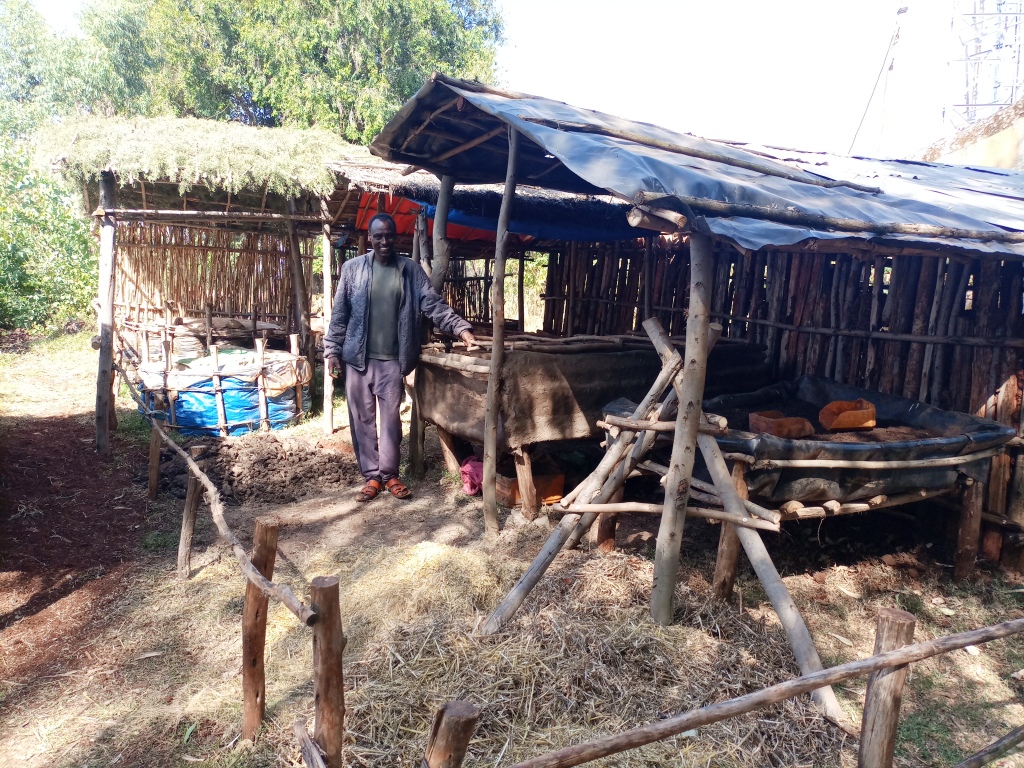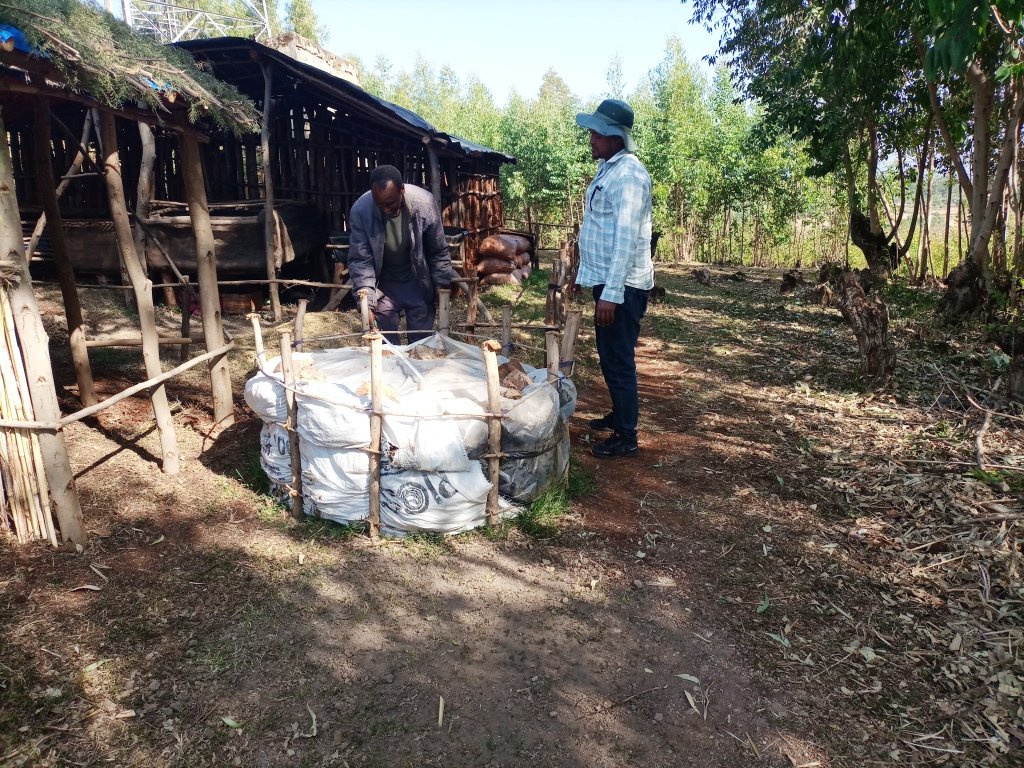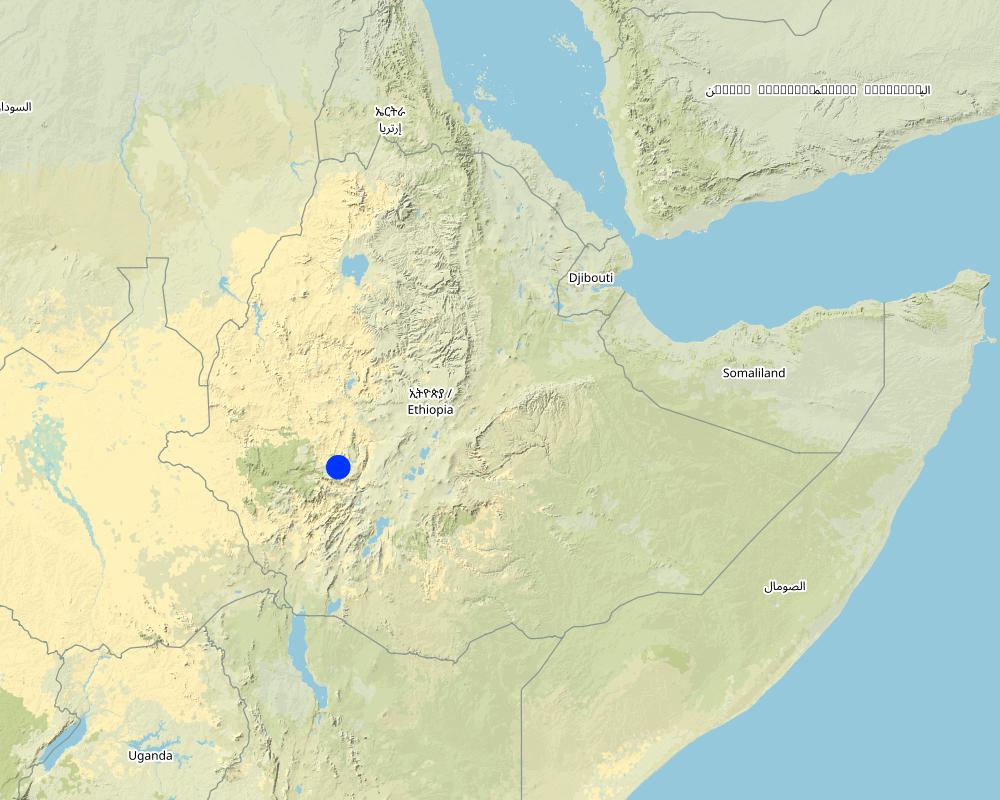Improved Compost [埃塞俄比亚]
- 创建:
- 更新:
- 编制者: GERBA LETA
- 编辑者: Noel Templer, Julia Doldt, Kidist Yilma
- 审查者: William Critchley, Rima Mekdaschi Studer
Kompoosti Fooyya'a
technologies_6649 - 埃塞俄比亚
查看章节
全部展开 全部收起1. 一般信息
1.2 参与该技术评估和文件编制的资源人员和机构的联系方式
关键资源人
土地使用者:
Abdulqadir Mohammed
Farmer
埃塞俄比亚
有助于对技术进行记录/评估的项目名称(如相关)
Soil protection and rehabilitation for food security (ProSo(i)l)有助于对技术进行记录/评估的机构名称(如相关)
Alliance Bioversity and International Center for Tropical Agriculture (Alliance Bioversity-CIAT) - 肯尼亚1.3 关于使用通过WOCAT记录的数据的条件
编制者和关键资源人员接受有关使用通过WOCAT记录数据的条件。:
是
1.4 所述技术的可持续性声明
这里所描述的技术在土地退化方面是否存在问题,导致无法被认为是一种可持续的土地管理技术?:
否
注释:
The technology is very friendly to SLM since it restores soil fertility and improves the chemical, physical and biological properties of the soil.
1.5 参考关于SLM方法(使用WOCAT记录的SLM方法)的调查问卷
2. SLM技术的说明
2.1 技术简介
技术定义:
Improved compost making using “static pile” systems transforms organic material from plants and/or animals into high-value, rich organic compost. It demands less labour, and less time to reach maturity than conventional systems as it thoroughly mixes the ingredients at the beginning which precludes the need to turn the heap later.
2.2 技术的详细说明
说明:
Improved composting using static pile systems transforms organic material from plants and/or animals into high-value, rich organic compost. This compost can be prepared in a heap form, where the ingredients are thoroughly mixed and wrapped within a polyethylene sheet. Notably, white polyethylene has the role of intercepting sunlight and improving the solarization effects on weed seeds or wild species arbitrarily used as biomass for improved compost production. This technique accelerates the breakdown of the organic materials faster because it heats up the compost as part of the decomposition process. Accordingly, the compost reaches maturity in 60-70 days. Compost provides the crop with balanced nutrients and helps to increase the soil's organic matter content. It has long‐term, and short‐term effects on plant nutrition as nutrients are continuously released. It is an organic matter resource with the unique ability to improve soils' chemical, physical and biological properties. Improved compost is applied in rows for vegetables and small cereal crops but spot application (planting holes) is employed for large cereal crops such as maize. The application is on an incremental basis year and again to reach out to the large size of lands. In principle, as the nutrients are slowly released, they may not need a continuous application like chemical fertilizers.
Improved compost-making requires 12-15 wooden pegs 1m high each supported by horizontal bars/string, to form a round structure. The interior is lined with plastic sheeting, then thoroughly mixed ingredients, including coffee hulls, ash, livestock manure, crop residues, livestock urine, water, and chaff are mixed and piled before being sealed in the structure. Unlike the mainstream heaps or pits types of composting, it doesn’t need turning. Therefore, this technique reduces labour requirement, and is liked by the users who have been piloting the technology. The relatively short maturity date also enables it to be produced at least twice a year during the offseason. Compost is prepared around the homestead – which allows closer attention - using livestock urine, manure, and house refuse.
In most of Ethiopia's central and western highlands, soil degradation is a severe issue. Soil acidity has become a growing problem challenging the livelihoods of smallholders. Thus, countering the negative effect of degradation and acidity through producing and using organic fertilizers is a key strategy. However, it is essential that the resources of biomass, family labour, skills and motivation, are combined to ensure sustainable land for crop production. From end users' observations and analysis, improved compost restores soil fertility. It increases yield as well as grain quality: this has been proved by testing the grain compared with the harvest where only chemical fertilizers have been applied. Farmers prefer the simplicity of preparing improved compost to the conventional method, and appreciate its role in improving yield and grain quality as well as reducing the labour demand.
2.3 技术照片
关于照片的一般说明:
The photo portrays the farmer measuring the total area (by cubic meters) where the improved compost is piled.
2.4 技术视频
注释、简短说明:
Video of the technology is not recorded.
2.5 已应用该技术的、本评估所涵盖的国家/地区/地点
国家:
埃塞俄比亚
区域/州/省:
Oromia
有关地点的进一步说明:
Babo kebele of Kersa district, Jimma zone
具体说明该技术的分布:
- 适用于特定场所/集中在较小区域
技术现场是否位于永久保护区?:
否
Map
×2.6 实施日期
注明实施年份:
2022
2.7 技术介绍
详细说明该技术是如何引入的:
- 通过土地使用者的创新
- 通过项目/外部干预
注释(项目类型等):
Improved compost preparation was introduced by local NGOs known as FC Ethiopia that arranged experience exchange visits to a few farmers in the Arsi Zone of Oromia. A proactive farmer inspired by the technology outdid what he had observed during his visit. He continued inspiring the surrounding community by preparing improved compost with rich ingredients and early maturing capacity compared to conventional compost production.
3. SLM技术的分类
3.1 该技术的主要目的
- 改良生产
- 减少、预防、恢复土地退化
- 保护生态系统
- 保持/提高生物多样性
- 创造有益的经济影响
3.2 应用该技术的当前土地利用类型
同一土地单元内混合使用的土地::
否

农田
- 一年一作
- 多年一作(非木材)
- 乔木与灌木的种植
年作 - 具体指明作物:
- 谷物类 - 玉米
- 谷类 - 小麦(春季)
- 豆科牧草和豆类 - 豆子
- Hot pepper
多年生(非木质)作物 - 指定作物:
- 香蕉/芭蕉/蕉麻
- 甘蔗
乔木和灌木种植 - 指定作物:
- 鳄梨
每年的生长季节数:
- 1
采用间作制度了吗?:
是
如果是,说明哪些作物是间作的:
Haricot beans with maize
采用轮作制度了吗?:
是
如果是,请具体说明:
Maize rotate by wheat and then faba beans.
3.3 由于技术的实施,土地使用是否发生了变化?
由于技术的实施,土地使用是否发生了变化?:
- 否(继续问题3.4)
3.4 供水
该技术所应用土地的供水:
- 雨养
注释:
Sources of water supply for improved compost making can be steams or groundwater. However, the compost can be applied to both the rainfed or irrigated agriculture.
3.5 该技术所属的SLM组
- 农畜综合管理
- 土壤肥力综合管理
3.6 包含该技术的可持续土地管理措施

农艺措施
- A2:有机质/土壤肥力
- A3:土壤表面处理
A3:区分耕作制度:
A 3.3: Full tillage (< 30% soil cover)

管理措施
- M2:改变管理/强度级别
- M5:物种组成的控制/变化
注释:
Applying organic fertilizer to the farm stimulates the regeneration of the lost wild species on the farm.
3.7 该技术强调的主要土地退化类型

土壤水蚀
- Wt:表土流失/地表侵蚀

化学性土壤退化
- Cn:肥力下降和有机质含量下降(非侵蚀所致)
- Ca:酸化

物理性土壤退化
- Ps:有机土壤沉降,土壤沉降

生物性退化
- Bc:植被覆盖的减少
- Bh:栖息地丧失
- Bs:质量和物种组成/多样性的下降
- Bl:土壤寿命损失

水质恶化
- Hs:地表水良变化
- Hp:地表水水质下降
3.8 防止、减少或恢复土地退化
具体数量名该技术与土地退化有关的目标:
- 减少土地退化
- 修复/恢复严重退化的土地
注释:
The production and use of organic fertilizer improve soil fertility, regenerates lost species, and improve plant and animal biodiversity. Compost improves the vigorous growth of the crop, plant colour, and crop production. It also improves the rooting system, extends the grain filling period by about 20 days compared to the plot with chemical fertilizers, increases the number of ears/plants and seeds per ear in maize, etc.
4. 技术规范、实施活动、投入和成本
4.1 该技术的技术图纸
技术规范(与技术图纸相关):
Picture that clearly describe the technology is affixed. Detail description is available under the description.
4.2 有关投入和成本计算的一般信息
具体说明成本和投入是如何计算的:
- 每个技术单元
指定单位:
Compost production structure
指定单位面积(如相关):
6-7m3
其它/国家货币(具体说明):
ETB
如相关,注明美元与当地货币的汇率(例如1美元=79.9巴西雷亚尔):1美元=:
53.12
注明雇用劳工的每日平均工资成本:
100
4.3 技术建立活动
| 活动 | 时间(季度) | |
|---|---|---|
| 1. | Select site and constructing the structure. | During the off-season particularly right after harvest when adequate biomass is available. |
| 2. | Collecting ingredients for compost making. | During crop harvest |
| 3. | Thoroughly combine the ingredients and seal. | After materials are ready to make the heap. |
| 4. | Harvest/open and dry the compost on open air. | Six to seven weeks after piling the compost. |
4.4 技术建立所需要的费用和投入
| 对投入进行具体说明 | 单位 | 数量 | 单位成本 | 每项投入的总成本 | 土地使用者承担的成本% | |
|---|---|---|---|---|---|---|
| 劳动力 | Labor | PDs | 5.0 | 100.0 | 500.0 | 100.0 |
| 设备 | Spade | number | 1.0 | 300.0 | 300.0 | |
| 设备 | Reck | number | 1.0 | 160.0 | 160.0 | 100.0 |
| 设备 | Machete | number | 1.0 | 1000.0 | 1000.0 | 100.0 |
| 设备 | Sickle | number | 1.0 | 500.0 | 500.0 | 100.0 |
| 施工材料 | Posts for peg making | number | 2.0 | 50.0 | 100.0 | 100.0 |
| 施工材料 | Horizontal bars | number | 5.0 | 10.0 | 50.0 | 100.0 |
| 施工材料 | Strings | meter | 12.0 | 10.0 | 120.0 | 100.0 |
| 施工材料 | Polyethylene sheet | meter | 14.0 | 50.0 | 700.0 | 100.0 |
| 技术建立所需总成本 | 3430.0 | |||||
| 技术建立总成本,美元 | 64.57 | |||||
如果土地使用者负担的费用少于100%,请注明由谁负担其余费用:
So far, the district/Woreda Office of Agriculture covered the cost of the spade for participating model farmers in the training as an incentive.
注释:
Cost of making or producing the technology is largely covered by the land users themselves. District SLM experts provide technical support and monitoring the land users activities on irregular basis. It is only the labor cost and some expendable supplies that are demanded every other time. Otherwise, materials are reused for the perpetuation of compost production.
4.5 维护/经常性活动
注释:
Essentially, improved compost making does not need visible maintenance work. Rather it aspires collection of inputs or materials to perpetuate production of compost. Such activities can be considered as recurrent activities that ensure compost production on sustainable basis.
4.6 维护/经常性活动所需要的费用和投入(每年)
| 对投入进行具体说明 | 单位 | 数量 | 单位成本 | 每项投入的总成本 | 土地使用者承担的成本% | |
|---|---|---|---|---|---|---|
| 劳动力 | Labor | PDs | 5.0 | 100.0 | 500.0 | 100.0 |
| 施工材料 | Plastic sheet | meter | 14.0 | 50.0 | 700.0 | 100.0 |
| 施工材料 | Posts | number | 2.0 | 50.0 | 100.0 | 100.0 |
| 技术维护所需总成本 | 1300.0 | |||||
| 技术维护总成本,美元 | 24.47 | |||||
注释:
The estimated cost is only to construct one structure that allows the preparation of about 6-7 m3 of compost. If a farmer wants to produce as much compost as possible simultaneously, the material and labor demand can be doubled or quadrupled.
4.7 影响成本的最重要因素
描述影响成本的最决定性因素:
Material prices are also variable because of economic instability and price fluctuation. In general, the cost is inconsistent because of inflation.
5. 自然和人文环境
5.1 气候
年降雨量
- < 250毫米
- 251-500毫米
- 501-750毫米
- 751-1,000毫米
- 1,001-1,500毫米
- 1,501-2,000毫米
- 2,001-3,000毫米
- 3,001-4,000毫米
- > 4,000毫米
有关降雨的规范/注释:
The site receives high rainfall in summer maximum (June to September). From January to May, it is the dry season with short showers in March/April.
注明所考虑的参考气象站名称:
Jimma
农业气候带
- 半湿润
5.2 地形
平均坡度:
- 水平(0-2%)
- 缓降(3-5%)
- 平缓(6-10%)
- 滚坡(11-15%)
- 崎岖(16-30%)
- 陡峭(31-60%)
- 非常陡峭(>60%)
地形:
- 高原/平原
- 山脊
- 山坡
- 山地斜坡
- 麓坡
- 谷底
垂直分布带:
- 0-100 m a.s.l.
- 101-500 m a.s.l.
- 501-1,000 m a.s.l.
- 1,001-1,500 m a.s.l.
- 1,501-2,000 m a.s.l.
- 2,001-2,500 m a.s.l.
- 2,501-3,000 m a.s.l.
- 3,001-4,000 m a.s.l.
- > 4,000 m a.s.l.
关于地形的注释和进一步规范:
Topography (5.2) does not define improved compost as a practice/technology. The above questions are addressed merely to describe the site where the technology was applied. The technology can be applied in diverse landforms or slopes as long as necessary ingredients and issues that call for mitigation are experienced.
5.3 土壤
平均土层深度:
- 非常浅(0-20厘米)
- 浅(21-50厘米)
- 中等深度(51-80厘米)
- 深(81-120厘米)
- 非常深(> 120厘米)
土壤质地(表土):
- 中粒(壤土、粉土)
土壤质地(地表以下> 20厘米):
- 中粒(壤土、粉土)
表土有机质:
- 低(<1%)
如有可能,附上完整的土壤描述或具体说明可用的信息,例如土壤类型、土壤酸碱度、阳离子交换能力、氮、盐度等。:
The soil types is Nitosol and soil pH is about 5 on average.
5.4 水资源可用性和质量
地下水位表:
5-50米
地表水的可用性:
好
水质(未处理):
良好饮用水
水质请参考::
地表水
水的盐度有问题吗?:
否
5.5 生物多样性
物种多样性:
- 中等
栖息地多样性:
- 中等
关于生物多样性的注释和进一步规范:
There is declining biodiversity because of the increasing degradation of the soil.
5.6 应用该技术的土地使用者的特征
定栖或游牧:
- 定栖的
生产系统的市场定位:
- 混合(生计/商业)
非农收入:
- 低于全部收入的10%
相对财富水平:
- 丰富
个人或集体:
- 个人/家庭
机械化水平:
- 畜力牵引
性别:
- 男人
土地使用者的年龄:
- 中年人
5.7 应用该技术的土地使用者使用的平均土地面积
- < 0.5 公顷
- 0.5-1 公顷
- 1-2 公顷
- 2-5公顷
- 5-15公顷
- 15-50公顷
- 50-100公顷
- 100-500公顷
- 500-1,000公顷
- 1,000-10,000公顷
- > 10,000公顷
这被认为是小规模、中规模还是大规模的(参照当地实际情况)?:
- 小规模的
5.8 土地所有权、土地使用权和水使用权
土地所有权:
- 州
- 个人,有命名
土地使用权:
- 个人
用水权:
- 自由进入(无组织)
土地使用权是否基于传统的法律制度?:
否
具体说明:
He accessed land redistribution through the local government.
5.9 进入服务和基础设施的通道
健康:
- 贫瘠
- 适度的
- 好
教育:
- 贫瘠
- 适度的
- 好
技术援助:
- 贫瘠
- 适度的
- 好
就业(例如非农):
- 贫瘠
- 适度的
- 好
市场:
- 贫瘠
- 适度的
- 好
能源:
- 贫瘠
- 适度的
- 好
道路和交通:
- 贫瘠
- 适度的
- 好
饮用水和卫生设施:
- 贫瘠
- 适度的
- 好
金融服务:
- 贫瘠
- 适度的
- 好
注释:
As the farmland is closer to all-weather roads and the district town, the farmer can easily access almost all of the facilities in the area.
6. 影响和结论性说明
6.1 该技术的现场影响
社会经济效应
生产
作物生产
SLM之前的数量:
2 tons/hectare
SLM之后的数量:
2.8 tons/hectare
注释/具体说明:
Maize yield has immensely increased during the first harvest with compost as compared to the plot with NSP fertilizer at the rate of 100 kg/ha. As nutrients from organic fertilizers gradually available, it is expected to increase in the coming years.
作物质量
注释/具体说明:
Land users communicated the positive effects of using compost on grain size and overall quantity of production.
饲料生产
注释/具体说明:
As biomass production is increasing, the part of crop residue that is used for livestock feed is also increasing.
产品多样性
土地管理
注释/具体说明:
Farmlands where improved compost applied increases soil aggregate stability as compared to the farmland where only chemical fertilizers is applied.
收入和成本
农业投入费用
注释/具体说明:
Using organic fertilizer (improved compost) reduces land users investment on chemical fertilizers.
农业收入
注释/具体说明:
It correlates with increasing production per unit of land.
收入来源的多样性
注释/具体说明:
The farmer also generate income from the sale of compost itself.
社会文化影响
食品安全/自给自足
健康状况
注释/具体说明:
Convergent to food and nutrition security.
社区机构
注释/具体说明:
Farmer group formation is promoted for peer learning.
生态影响
水循环/径流
水量
水质
注释/具体说明:
Ground cover contributes to filtering the downslope runoff and siltation.
地表径流
多余水的排放
注释/具体说明:
The organic matter in the improved compost improve soil structure and simplify water drainage down in soil horizon.
土壤
土壤水分
土壤覆盖层
注释/具体说明:
Improved compost increase biomass production and soil cover.
土壤流失
土壤堆积
土壤结壳/密封
注释/具体说明:
Improved compost promotes soil aggregate stability.
土壤压实
养分循环/补给
土壤有机物/地下C
注释/具体说明:
Salinity is uncommon in the district.
酸度
生物多样性:植被、动物
植被覆盖
生物量/地上C
植物多样性
注释/具体说明:
Compost promotes the growth of wild species and/or promotes the succession of some lost species.
动物多样性
有益物种
栖息地多样性
害虫/疾病控制
减少气候和灾害风险
干旱影响
碳和温室气体的排放
注释/具体说明:
It increases surface and subsurface biomass production and sequester soil carbon.
微气候
对现场影响的评估(测量)进行具体说明:
Quantifying the positive or negative effects of technology demands the documentation of different facets of the technology which is virtually lacking. In most cases, farmer's responses and expert's opinions were used to addressing the comprehensive questions in the questionnaire.
6.2 该技术的场外影响已经显现
水资源可用性
注释/具体说明:
Slightly increases as it improves the soil infiltration potential.
旱季稳定可靠的水流
下游洪水
下游淤积
注释/具体说明:
It positively associate with reduction of the runoff due to good ground cover.
地下水/河流污染
温室气体的影响
注释/具体说明:
Such impact can be achieved in the long-term.
对场外影响(测量)的评估进行具体说明:
Improving soil fertility increases biodiversity and reduces multiple adverse effects of degradation on the environment.
6.3 技术对渐变气候以及与气候相关的极端情况/灾害的暴露和敏感性(土地使用者认为的极端情况/灾害)
渐变气候
渐变气候
| 季节 | 增加或减少 | 该技术是如何应对的? | |
|---|---|---|---|
| 年温度 | 增加 | 适度 | |
| 季节性温度 | 旱季 | 增加 | 非常好 |
其他气候相关的后果
其他气候相关的后果
| 该技术是如何应对的? | |
|---|---|
| 延长生长期 | 非常好 |
6.4 成本效益分析
技术收益与技术建立成本相比如何(从土地使用者的角度看)?
短期回报:
稍微积极
长期回报:
积极
技术收益与技术维护成本/经常性成本相比如何(从土地使用者的角度看)?
短期回报:
稍微积极
长期回报:
积极
注释:
The benefits accrued from the application of technology (improved compost) increases overtime as the rate of nutrient adsorption or release of the elements is on a gradual basis as compared to chemical fertilizers. The return remains positive despite variations in temporal and the degrees.
6.5 技术采用
- 1-10%
如若可行,进行量化(住户数量和/或覆盖面积):
About five farmers were adopted in one village. It is spreading in a similar manner over the other areas.
在所有采用这项技术的人当中,有多少人是自发的,即未获得任何物质奖励/付款?:
- 91-100%
注释:
So far, the farmer is adopting through advisory services and familiarization with the technology via exchange visits. However, the visited farmer increased the number of ingredients used as feedstock for compost production compared to what he had seen during his visit to the Arsi zone of Oromia.
6.6 适应
最近是否对该技术进行了修改以适应不断变化的条件?:
否
6.7 该技术的优点/长处/机会
| 土地使用者眼中的长处/优势/机会 |
|---|
| Improve soil fertility and reduce acidity on gradual basis. |
| Increase grain and biomass yield and quality of the crop. |
| Generate income from the sale of compost. |
| 编制者或其他关键资源人员认为的长处/优势/机会 |
|---|
| It reduces the investment cost on chemical fertilizers. |
| Shortly mature compared to conventional compost making, enabling more composts to be produced. |
| It reduces labor costs as an overturning operation is exempted. |
6.8 技术的弱点/缺点/风险及其克服方法
| 土地使用者认为的弱点/缺点/风险 | 如何克服它们? |
|---|---|
| Intensive labour during planting (transport to the farm and implement row or spot application) depending on the crop types. | Promote labour-sharing arrangements with neighboring peers, engage family labor, and use necessary farm tools such as wheelbarrows to transport to the nearby farms. |
| 编制者或其他关键资源人员认为的弱点/缺点/风险 | 如何克服它们? |
|---|---|
| Introduction of the technology is steered by soil fertility improvement department of the district office on piecemeal basis. | Need popularization via the extension system. This demands institutionalizing the technology as the best technology/practice. |
7. 参考和链接
7.1 信息的方法/来源
- 实地考察、实地调查
Two farmers
- 与土地使用者的访谈
Only a farmer
- 与SLM专业人员/专家的访谈
Soil fertility improvement process owner.
(现场)数据是什么时候汇编的?:
10/02/2023
7.2 参考可用出版物
标题、作者、年份、ISBN:
Soil Fertility Management: An introductory Fact-Sheet for Farmers and Projects.Organic Exchange. 2009
可以从哪里获得?成本如何?
free online
7.3 链接到网络上的相关信息
标题/说明:
Making and Using Compost for Organic Farming
URL:
https://eorganic.org/node/2880
7.4 一般注释
The questionnaire is broad and often goes beyond the general feature of a technology. Of course, strict documentation of the different features of the technology are desirable.
链接和模块
全部展开 全部收起链接
无链接
模块
无模块





